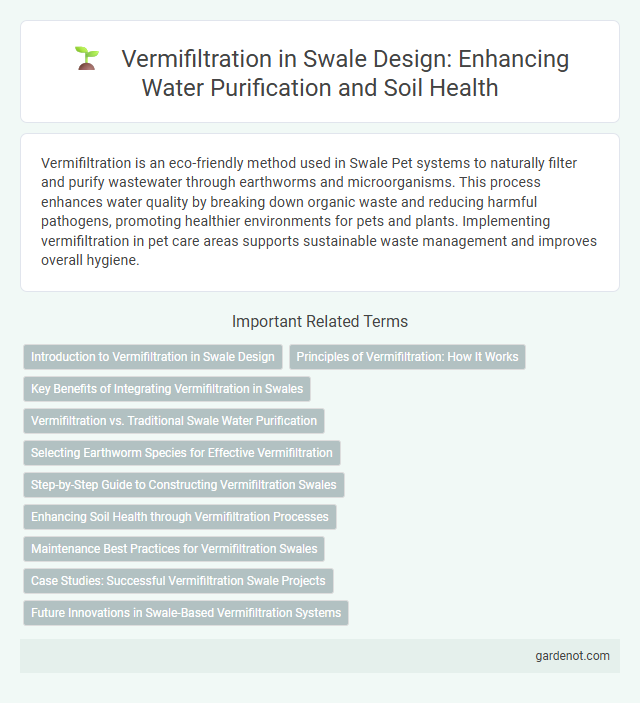Vermifiltration is an eco-friendly method used in Swale Pet systems to naturally filter and purify wastewater through earthworms and microorganisms. This process enhances water quality by breaking down organic waste and reducing harmful pathogens, promoting healthier environments for pets and plants. Implementing vermifiltration in pet care areas supports sustainable waste management and improves overall hygiene.
Introduction to Vermifiltration in Swale Design
Vermifiltration integrates earthworm activity into swale design to enhance wastewater treatment through natural biofiltration and microbial processes. This method improves nutrient removal, reduces organic load, and promotes soil aeration within swale systems, optimizing water quality management and sustainable stormwater treatment. Implementing vermifiltration in swales supports ecological balance by harnessing biological filtration mechanisms for efficient pollutant degradation.
Principles of Vermifiltration: How It Works
Vermifiltration operates by utilizing earthworms and microbial activity to break down organic waste, enhancing the filtration process in swales. The worms consume organic matter, facilitating decomposition and improving soil aeration while microbes degrade pollutants and pathogens. This biological interaction results in efficient treatment of runoff, reducing contaminants and promoting healthier soil and water quality in swale systems.
Key Benefits of Integrating Vermifiltration in Swales
Integrating vermifiltration in swales enhances nutrient removal and significantly reduces organic pollutants through earthworm activity, improving stormwater quality. This process promotes soil aeration and microbial diversity, accelerating the breakdown of contaminants and increasing infiltration rates. Vermifiltration also helps in minimizing erosion and supports sustainable water management by maintaining swale functionality during heavy rainfall events.
Vermifiltration vs. Traditional Swale Water Purification
Vermifiltration enhances swale water purification by incorporating earthworms and microbial activity to accelerate organic matter decomposition and nutrient removal, improving water quality more efficiently than traditional swales. Traditional swales rely mainly on sedimentation and plant uptake, which can be slower and less effective in removing pathogens and heavy metals. By integrating vermifiltration, pollution bioaccumulation decreases, leading to improved groundwater recharge and reduced eutrophication risks in surrounding ecosystems.
Selecting Earthworm Species for Effective Vermifiltration
Selecting earthworm species for effective vermifiltration requires consideration of their adaptability to local climate, organic waste type, and soil conditions found in swales. Eisenia fetida and Lumbricus rubellus are widely recognized for their high efficiency in decomposing organic matter and promoting nutrient-rich filtrate production. Optimizing earthworm species selection enhances biodegradation rates and improves water quality management in swale-based vermifiltration systems.
Step-by-Step Guide to Constructing Vermifiltration Swales
Constructing vermifiltration swales involves layering organic waste and soil to create a habitat for earthworms that naturally filter stormwater runoff. Begin by excavating a shallow trench along the swale's contour, then add a base layer of coarse gravel for drainage, followed by a mixture of compost and soil to support microbial activity. Introduce earthworms, such as Eisenia fetida, to enhance decomposition and improve water infiltration, ensuring the swale efficiently reduces pollutants and manages excess water.
Enhancing Soil Health through Vermifiltration Processes
Vermifiltration leverages earthworms and microorganisms to improve soil structure and nutrient cycling, enhancing soil fertility in swales. This process increases organic matter decomposition, leading to higher levels of humus and improved soil aeration. Enhanced microbial activity within vermifiltration systems promotes nutrient availability and water retention, critical for sustainable soil health in stormwater management.
Maintenance Best Practices for Vermifiltration Swales
Maintaining vermifiltration swales requires regular inspection to ensure optimal worm activity and prevent clogging by removing excess organic matter and sediment buildup. Monitoring moisture levels is crucial, as vermifiltration systems depend on consistent hydration to support earthworm populations for effective filtration. Implementing routine checks of inlet and outlet structures helps sustain flow rates and prevents damage to the swale's biofiltration media.
Case Studies: Successful Vermifiltration Swale Projects
Successful vermifiltration swale projects demonstrate significant improvements in stormwater management and water quality through the integration of earthworm-mediated filtration systems. Case studies from urban and agricultural settings highlight reductions in nutrient loads, suspended solids, and heavy metals, with sites reporting up to 70% decrease in total nitrogen and phosphorus concentrations. These projects underscore vermifiltration's capacity to enhance swale functionality by promoting biological degradation and improving soil permeability.
Future Innovations in Swale-Based Vermifiltration Systems
Future innovations in swale-based vermifiltration systems are integrating advanced biofiltration media to enhance nutrient removal and pathogen reduction. Smart sensors and IoT technologies enable real-time monitoring of soil moisture, worm activity, and pollutant levels, optimizing filtration efficiency. Emerging research emphasizes genetically optimized earthworm strains for improved organic waste decomposition and resilience in variable climate conditions.
Vermifiltration Infographic

 gardenot.com
gardenot.com